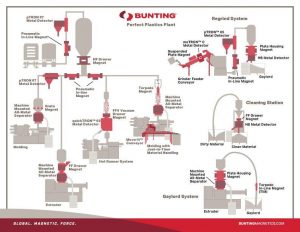Get in touch with us at our toll-free number 1-800-835-2526 or request a quote here:
Where are Magnetic Separators and Metal Detectors Located in a Plastics Plant?

It can be difficult to determine the ideal location for removing metal within a plastics processing plant. In order to assist plastics engineers, Bunting has released a Perfect Plant Diagram that illustrates optimum locations for magnetic separators and metal detectors within a plastics plant. In this blog, we will review some of the locations, designs, and types of magnetic separators and metal detectors that are commonly used in plastics plants.
Perfect Plant Diagram
In this flowsheet, you can see that a typical plastics plant has been divided into different zones, with the optimum locations for metal removal identified. To achieve the highest level of metal removal, it is recommended that a plastics plant install a combination of both magnetic separators and metal detectors. In this type of configuration, the magnetic separator will trap and hold ferrous metal, which makes up the majority of metal contamination in any given plastics plant. Then, the metal detector will be able to focus on more difficult to remove non-ferrous metals. This combination of equipment excels at minimizing both product loss as well as production downtime.
Equipment
Here, we will review the recommended types and locations of equipment to install at key points within a plastics processing plant.
Stage 1: Primary Feed to Storage
Plastics processing plants bring in their material in one of two ways. In one scenario, they will purchase gaylords or supersacks filled with material. In the other scenario, they utilize pneumatic transfer systems to transport material from trucks or railcars. When raw material feed enters the first stage of the process, it is common for tramp metal to accompany it. Because of this, it is recommended to place magnetic separators and metal detectors on the pneumatic line that feeds the primary storage silo. Doing this will reduce the amount of tramp metal introduced to the process from external sources.
Recommendations:
• Pneumatic Inline Magnet (PIM) for ferrous metal removal
• pTRON 05 Metal Detectors for all metal removal
Stage 2: Exiting Bulk Storage Silo
Metal contamination can cause serious damage to equipment in a facility. It can also result in defects occurring in the end plastic product. To avoid these undesirable outcomes, it is critical to continually identify and trap any metal contamination that may be present in a facility. Within a plant, metal contamination originates from fatigued equipment (e.g. pumps, screens), general wear and tear (e.g. pipes, silos), and accidental introduction of metal from personnel who are conducting maintenance and performing other work. Because of the many different potential entry points, multiple stages of metal removal are required as well.
After raw material has left a storage silo, the feed passes through pneumatic inline magnets or a gravity fed HF drawer magnet.
• Drawer Filter Magnet for ferrous metal removal
• Pneumatic Inline Magnet (PIM) for ferrous metal removal
Stages 3 & 4: Molding Line and Molding (with just-in-time material handling)
If metal contamination enters molding lines, it can cause costly damage to machinery. This will not only negatively affect productivity, but it will also increase the percentage of finished product rejects. By implementing a combination of both magnetic separators and metal detectors, it is possible to prevent such issues. The final combination will ultimately be determined by the installation, but options include:
• pTRON 05 Metal Detector to detect and remove a range of metal contaminants from pneumatic lines
• A grate magnet mounted in the hopper of the molding machine to remove ferrous metal
• FF drawer filter magnet for ferrous metal removal
• Machine Mounted All-Metal Separator to remove all metals, both ferrous and non-ferrous
Stage 4: Extruder
Metal contamination also causes damage to extruders within a facility. Here, again, a combination of magnetic separators and metal detectors provides important protection.
• FF drawer filter magnet for ferrous metal removal
• Machine Mounted All-Metal Separator to remove all metals, both ferrous and non-ferrous
Stage 5: Hot Runner System
A hot runner system is an assembly of heated components that are used in plastic injection molds in order to inject molten plastic into the cavities of the mold. If metal contamination enters a hot runner system, it can cause catastrophic and costly damage. For a pneumatic fed system, again, a combination of magnetic separation and metal detection is recommended.
Stage 6: Reworking and Recycling Rejects & Offcuts
It is expected that within any plastic manufacturing process, a proportion of the production will be rejected, such as by metal detectors. Additionally, there will be off-cuts and pre-production runs that produce recoverable waste. Within this “waste,” it is expected that there will be more metal contamination due to the collection process as well as because some materials have been rejected due to contamination already.
The three recycling processes include:
Regrind
Post Industrial Regrind, or PIR, describes the process of recapturing scrap plastics and resins from a given manufacturing process. The regrind process can happen, for example, when lids are being made for plastic containers and bottles. In regrind, a wide range of magnetic separators and metal detectors are used, including:
• Suspended Plate Magnet: positioned over the feed conveyor to lift and remove larger pieces of ferrous metal.
• meTRON™ 05C Metal Detector: mounted on the conveyor to detect and remove non-ferrous metal
• Pneumatic Inline Magnet: positioned on the pneumatic line feeding the storage silo to remove smaller ferrous metal fragments.
• pTRON™ 05 Metal Detector: positioned following the inline magnet to detect and remove smaller pieces of non-ferrous metal.
• Plate Housing Magnet: a magnetic separator designed with two plate magnets facing each other across an open gap. This type of magnet is ideal for handling materials prone to bridging when there are flow restrictions.
• quickTRON™ 03 Metal Detector: acts as a final check to detect and remove any remaining rogue metal.
Cleaning Stations:
Cleaning stations reprocess previously rejected material in order to recover any good material that may be entrapped within. Material initially passes through a magnetic separator, followed by a metal detector.
• FF Drawer Filter Magnet
• quickTRON™ 03 Metal Detector
Bin Dump System
In some operations, waste plastic will be extruded immediately to enable future use. It is vital that magnetic separators and metal detectors are installed to protect the extruder. Recommended equipment includes:
• Inline Magnet
• Plate Housing Magnet
• Machine Mounted All-Metal Separator
Cost Savings Protection
Bunting has developed recommendations for plastics plants based on decades of working with plastics producers and processers around the world. Still, each plastics processing facility is unique. For assistance in selecting the correct types and designs of magnetic separators and metal detectors, as well as assistance in selecting optimum locations for installation, contact Bunting today.
